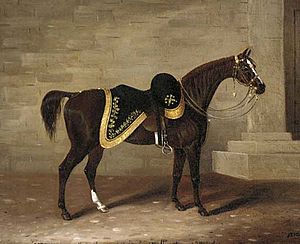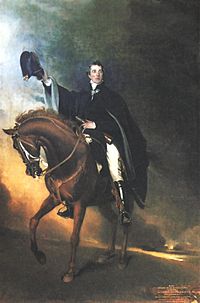Copenhagen (horse) facts for kids
Quick facts for kids Copenhagen |
|
|---|---|

Copenhagen as painted in his retirement by Samuel Spode.
|
|
| Sire | Meteor |
| Grandsire | Eclipse |
| Dam | Lady Catherine (half-bred) |
| Damsire | John Bull |
| Sex | Stallion |
| Foaled | 1808 |
| Died | 12 February 1836 (aged 27–28) |
| Country | United Kingdom |
| Colour | Chestnut |
| Breeder | General Grosvenor |
| Owner | 1) General Grosvenor 2) Marquis of Londonderry 3) Duke of Wellington |
| Record | 12: 2-2-7 |
| Honours | |
| Honoured with a full military funeral upon his passing. | |
Copenhagen (born 1808 – died 1836) was a famous war horse. He belonged to the Duke of Wellington. The Duke rode Copenhagen during the very important Battle of Waterloo.
Copenhagen was a mix of Thoroughbred and Arabian horse breeds. He was born in 1808. He was named after a British victory in the Second Battle of Copenhagen. Copenhagen raced for a short time in England. He won two races and placed third in many others.
In 1813, Copenhagen was sent to Spain. There, he was sold to the Duke of Wellington. Copenhagen became the Duke's favorite horse. He carried the Duke through the long Battle of Waterloo. Copenhagen lived out his retirement at the Duke's home, Stratfield Saye. He died on February 12, 1836, at 28 years old. A special marble headstone marks his grave.
Contents
Copenhagen's Early Life
Copenhagen was bred by General Grosvenor. His father was a horse named Meteor. Meteor had a good racing career. Copenhagen's mother was Lady Catherine. She was a mix of Thoroughbred and other breeds.
There are different stories about where Copenhagen was born. Some say his mother was in Denmark during a battle. Copenhagen was either born there or back in England. Most records show he was born in England in 1808.
What Copenhagen Looked Like
Copenhagen was about 15 hands tall. This is about 152 centimeters. He was a strong horse with a muscular body. He was a dark chestnut color. He also had two white spots on his heels.
The Duke of Wellington loved Copenhagen's strength. He said Copenhagen was not the fastest or prettiest horse. But he was the best for "bottom and endurance." This means he was very tough and could keep going for a long time. People thought his Arabian blood helped him be so strong.
Copenhagen's Racing Days

Copenhagen raced until he was four years old. He raced under General Grosvenor's name. He stopped racing in May 1812. He was a fairly good racehorse. He won two races during his short career.
Racing as a Three-Year-Old
Copenhagen started racing when he was three. In April, he came third in a race. A few days later, he won a small race. He also lost a few other races that year. In August, he won another race at Huntingdon. He finished third in a Gold Cup race the next day. He also placed third in a few other races that year.
Racing as a Four-Year-Old
Copenhagen raced three times in 1812. In May, he came third in two races. He also finished fourth in another race. After these races, Copenhagen stopped his racing career.
Copenhagen's Military Service

General Grosvenor sold Copenhagen in 1812. He was bought by Sir Charles Vane. Copenhagen was sent to Spain in 1813. This was during the Peninsular War. Sir Charles Vane was serving there.
Later, Copenhagen was sold to Colonel Charles Wood. The Colonel bought Copenhagen for the Duke of Wellington.
Wellington rode Copenhagen in several battles. Before the Battle of Waterloo, he rode him on a dangerous trip. This trip was to meet with Marshal Blücher. Copenhagen was the Duke's horse during the entire Battle of Waterloo. He carried the Duke for 17 hours straight during the battle. After the battle, the Duke patted Copenhagen. The horse playfully kicked towards the Duke's head, but the Duke quickly moved away.
Copenhagen remained the Duke's main horse. He was used during the time France was occupied after the war.
Retirement and Passing
After the war, the Duke still rode Copenhagen. He rode him in parades and special events. Some of Copenhagen's hair was even made into jewelry. The horse retired to the Duke's home, Stratfield Saye House. He lived there peacefully for the rest of his life. Copenhagen was known for liking attention. He would "kiss hands" and eat apples politely.
Copenhagen's Funeral and Grave
Copenhagen passed away on February 12, 1836. He was 28 years old. He was buried very early the next morning. He received a full military funeral. This took place at the Duke's home, Stratfield Saye House.
The Duke was there for the burial. He became very upset when he saw that one of Copenhagen's hooves had been cut off. This was taken as a souvenir. The Duke later tried to get the other hooves. But they had already decayed. The missing hoof was eventually returned to the Duke. It was later made into an ink-stand.
Copenhagen was first buried without a headstone. Years later, the Duke was asked to dig up Copenhagen's body. They wanted to display his skeleton next to Napoleon's horse, Marengo. But the Duke refused. He even pretended not to know where Copenhagen was buried.
A large Turkey Oak tree now shades Copenhagen's grave. It was planted in 1843 by the Duke's housekeeper. After the Duke's death, his son placed a marble grave marker. It has a special message, called an epitaph, for Copenhagen.
Here Lies
COPENHAGEN
The Charger ridden by
THE DUKE OF WELLINGTON
The entire day at the
BATTLE OF WATERLOO.
Born 1808. Died 1836.
God's humbler instrument though meaner clay
Should share the glory of that glorious day.
Copenhagen's Family Tree
| Sire Meteor (GB) Chestnut, 1783 |
Eclipse 1764 |
Marske | Squirt |
|---|---|---|---|
| Ruby Mare | |||
| Spilletta | Regulus | ||
| Mother Western | |||
| Merlin Mare 1765 |
Merlin | Second | |
| Sister to Blank | |||
| Mother Pratt | Marksman | ||
| Mixbury Mare | |||
| Dam Lady Catherine 1796 |
John Bull 1790 |
Fortitude | Herod |
| Snap Mare | |||
| Xantippe | Eclipse | ||
| Grecian Princess | |||
| Rutland Arabian Mare | Rutland Arabian | Unknown | |
| Unknown | |||
| A hunting mare | Unknown | ||
| Unknown |
- Copenhagen's father was a full-blooded Thoroughbred. His mother's side had some Arabian and other hunting horse blood.
- Copenhagen was related to a famous horse named Eclipse through both his father and mother's side.
Images for kids
-
Head-on view of Copenhagen in the Wellington Statue designed by Matthew Cotes Wyatt and unveiled in 1846. The second Duke thought that the horse's face was a good likeness of Copenhagen.
See also
 In Spanish: Copenhagen (caballo) para niños
In Spanish: Copenhagen (caballo) para niños



